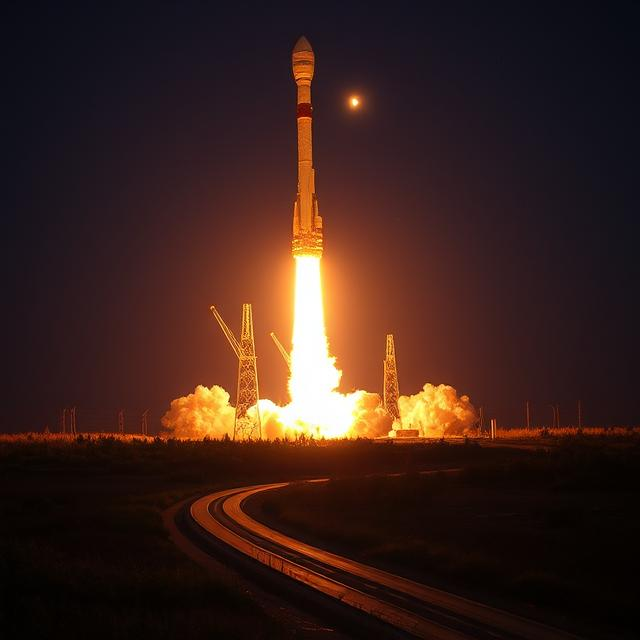The SpaceX Explosion: A Setback or a Stepping Stone for Innovation?
Space exploration has always been a fascinating domain of human endeavor, filled with remarkable triumphs and equally significant challenges. One of the most prominent companies pushing the boundaries of modern space travel is SpaceX, led by the visionary entrepreneur Elon Musk. SpaceX has been at the forefront of innovation, developing reusable rockets, launching groundbreaking missions, and changing the entire landscape of space exploration. However, despite its successes, the company has also faced setbacks, the most notable of which was a series of explosions that tested not only its engineering capabilities but also its resilience in the face of adversity.
Table of Contents
-
Introduction to SpaceX's Ambitious Vision
- 1.1 Early Beginnings of SpaceX
- 1.2 The Visionary Goal of Mars Colonization
-
The Rise of SpaceX and Its Technological Achievements
- 2.1 Reusable Rockets: A Game-Changer
- 2.2 Falcon 9 and the Impact on Space Launches
- 2.3 Starship: The Path to Mars
-
The Infamous Explosion: What Happened?
- 3.1 The Amos-6 Falcon 9 Explosion
- 3.2 Investigation and Cause of Failure
-
SpaceX’s Recovery: Lessons Learned
- 4.1 Engineering Solutions and Redesigns
- 4.2 Testing and Safety Enhancements
- 4.3 Restoring Trust and Confidence
-
SpaceX’s Resilience in the Face of Adversity
- 5.1 The SpaceX Philosophy of Failure
- 5.2 The Importance of Learning from Mistakes
- 5.3 The Role of Innovation and Risk-Taking
-
After the Explosion: SpaceX’s Continued Success
- 6.1 Successful Falcon 9 Missions Post-Explosion
- 6.2 The Falcon Heavy and Milestones
- 6.3 Crewed Missions to the ISS and Other Achievements
-
Broader Implications for the Space Industry
- 7.1 The Role of Private Companies in Space Exploration
- 7.2 SpaceX’s Transparency and Accountability
- 7.3 Impact on Investor and Public Confidence
-
SpaceX and the Future of Space Exploration
- 8.1 SpaceX’s Role in NASA’s Plans for the Moon and Mars
- 8.2 Starship and the Vision for Human Colonization of Mars
- 8.3 The Race to Space: Competition and Collaboration
-
Conclusion: A Stepping Stone Toward a New Era of Space Travel
- 9.1 Embracing Failure as a Path to Progress
- 9.2 SpaceX’s Impact on the Future of Space
1. Introduction to SpaceX's Ambitious Vision
1.1 Early Beginnings of SpaceX
SpaceX, founded in 2002 by Elon Musk, started with a bold mission: to reduce the cost of space travel and ultimately make humanity a multi-planetary species. The company’s goal was not just to develop rockets, but to create an entirely new approach to space technology. Musk’s vision was clear—by making space travel more affordable, humans would be able to explore the Moon, Mars, and beyond. The idea of reusable rockets, which could be reused multiple times, was revolutionary and set SpaceX on a path to transform the space industry.
1.2 The Visionary Goal of Mars Colonization
SpaceX’s ultimate vision is the colonization of Mars. Musk believes that to ensure the survival of the human race, humanity must spread beyond Earth. Mars is seen as the next viable destination for human habitation. SpaceX is building technologies to make this dream a reality, with the long-term goal of sending humans to Mars in the coming decades.
2. The Rise of SpaceX and Its Technological Achievements
2.1 Reusable Rockets: A Game-Changer
One of the most significant contributions SpaceX has made to the space industry is the development of reusable rocket technology. The company’s Falcon 9 rocket, capable of landing back on Earth after launching its payload into space, has radically changed the economics of space travel. Previously, rockets were discarded after each use, making space missions incredibly expensive. SpaceX’s reusable rockets, however, have reduced launch costs, making space more accessible.
2.2 Falcon 9 and the Impact on Space Launches
The Falcon 9 rocket became the backbone of SpaceX’s fleet. The rocket’s success in launching satellites, cargo, and crewed missions to the International Space Station (ISS) proved the reliability of reusable technology. The ability to land the rocket back on Earth and refurbish it for future missions made it one of the most cost-effective and environmentally friendly rockets in operation.
2.3 Starship: The Path to Mars
SpaceX’s Starship is designed to be the spacecraft that will carry humans to Mars. With its massive size and fully reusable nature, Starship represents the future of space travel. The development of Starship continues to be a critical step in Musk’s long-term vision of Mars colonization.
3. The Infamous Explosion: What Happened?
3.1 The Amos-6 Falcon 9 Explosion
Despite SpaceX’s advancements, the company faced a significant setback in 2016 when a Falcon 9 rocket exploded during a routine pre-launch test. The rocket, carrying the Amos-6 communications satellite, exploded at Cape Canaveral during a static fire test on September 1, 2016. The explosion destroyed both the rocket and its payload, causing a massive financial loss and forcing SpaceX to halt its launches for several months.
3.2 Investigation and Cause of Failure
Following the explosion, SpaceX launched a thorough investigation into the cause of the failure. The company discovered that the explosion was due to the rupture of a composite overwrapped pressure vessel (COPV) inside the rocket’s liquid oxygen tank. This caused a fire, which eventually led to the catastrophic failure of the rocket.
4. SpaceX’s Recovery: Lessons Learned
4.1 Engineering Solutions and Redesigns
After the explosion, SpaceX took immediate action to rectify the issue. Engineers redesigned the affected components and made improvements to the Falcon 9’s structural integrity. One of the significant changes was the redesign of the COPVs that had caused the explosion.
4.2 Testing and Safety Enhancements
SpaceX also implemented more rigorous testing protocols to ensure that such an incident would not happen again. The company’s focus on safety was reinforced with the addition of more extensive quality checks and enhanced systems to monitor every stage of the rocket’s launch and recovery.
4.3 Restoring Trust and Confidence
Despite the failure, SpaceX maintained transparency about the incident and its investigation. The company’s openness helped restore public and investor confidence, showing that it was committed to learning from its mistakes and improving its technology.
5. SpaceX’s Resilience in the Face of Adversity
5.1 The SpaceX Philosophy of Failure
Elon Musk’s approach to failure is central to SpaceX’s culture. Musk has often stated that failure is a necessary part of innovation. Rather than avoiding failure, SpaceX embraces it as a chance to learn, improve, and refine its technology.
5.2 The Importance of Learning from Mistakes
The company’s ability to learn from its failures is one of the driving forces behind its success. Each setback, whether it be a failed launch or an explosion, serves as an opportunity to make the technology more reliable and efficient.
5.3 The Role of Innovation and Risk-Taking
SpaceX’s success is built on innovation and risk-taking. The company continually pushes the boundaries of space technology, from developing reusable rockets to pioneering new methods of propulsion. It is this willingness to take risks that sets SpaceX apart from other aerospace companies.
6. After the Explosion: SpaceX’s Continued Success
6.1 Successful Falcon 9 Missions Post-Explosion
Despite the setback, SpaceX quickly resumed its operations. The company’s first launch after the explosion took place in December 2017, with the Falcon 9 successfully launching a satellite into orbit. This marked the beginning of a new phase of success for the company, with the Falcon 9 becoming one of the most reliable rockets in the world.
6.2 The Falcon Heavy and Milestones
In February 2018, SpaceX launched the Falcon Heavy, the most powerful operational rocket in the world at the time. The launch was a significant achievement, demonstrating SpaceX’s ability to handle heavy payloads and undertake more complex missions.
6.3 Crewed Missions to the ISS and Other Achievements
In May 2020, SpaceX successfully launched its first crewed mission to the International Space Station (ISS). This marked the first time a private company had launched astronauts into space. The success of the Crew Dragon mission was a historic achievement for SpaceX and demonstrated the company’s capability in human spaceflight.
7. Broader Implications for the Space Industry
7.1 The Role of Private Companies in Space Exploration
SpaceX’s explosion incident highlighted the growing role of private companies in space exploration. In recent years, SpaceX, along with other companies like Blue Origin, has shown that private sector involvement can drive innovation and lower costs in space exploration.
7.2 SpaceX’s Transparency and Accountability
The way SpaceX handled the explosion—investigating the cause, making improvements, and communicating openly with the public—has set a standard for accountability in the space industry. This transparency is essential in maintaining trust with investors, customers, and the public.
7.3 Impact on Investor and Public Confidence
The explosion could have been a significant blow to SpaceX’s reputation, but the company’s resilience and rapid recovery helped maintain investor and public confidence. The company’s transparency and commitment to improving its technology reassured stakeholders that SpaceX was not only capable of overcoming setbacks but also learning from them.
8. SpaceX and the Future of Space Exploration
8.1 SpaceX’s Role in NASA’s Plans for the Moon and Mars
SpaceX’s advancements have made it a crucial player in NASA’s Artemis program, which aims to return humans to the Moon and eventually send them to Mars. The company’s reusable rockets and spacecraft, such as the Starship, are seen as essential to achieving these ambitious goals.
8.2 Starship and the Vision for Human Colonization of Mars
The Starship, SpaceX’s next-generation spacecraft, is designed to carry humans to Mars and beyond. With its full reusability and massive payload capacity, Starship represents the future of space travel and plays a critical role in Musk’s vision of making humanity a multi-planetary species.
8.3 The Race to Space: Competition and Collaboration
SpaceX’s progress has also spurred competition and collaboration within the space industry. Companies like Blue Origin and Rocket Lab are pushing forward with their own innovations, while NASA and private companies work together to achieve common goals.
9. Conclusion: A Stepping Stone Toward a New Era of Space Travel
9.1 Embracing Failure as a Path to Progress
The SpaceX explosion serves as a reminder that failure is an essential part of progress. Every setback brings valuable lessons that pave the way for future success. SpaceX’s ability to learn from its mistakes and improve its technology is a testament to the company’s resilience and commitment to innovation.
9.2 SpaceX’s Impact on the Future of Space
As SpaceX continues to break new ground in space exploration, the company’s achievements will undoubtedly shape the future of human spaceflight. The lessons learned from past challenges, including the explosion, will continue to fuel SpaceX’s drive toward its ultimate goal: the colonization of Mars.
Keywords ;








.png)
0 Comments